Affiliate marketing is a long-term, sustainable, and cost-efficient answer to complement your paid marketing efforts… but sometimes you need a little help to get those efforts off the ground. It can be frustrating when you’ve set up an affiliate marketing program but not seeing much action on that front.
“A healthy affiliate program takes at least six months to show momentum,” said Aaron Paul, CEO of Paul Street.
“Besides offering messaging and payout testing, the biggest reason it takes time is that affiliates are all relationship-driven. Most brands should know that in order to get high-performing affiliates, it’s all about getting to know them on a personal level and building the foundation for a long-term mutually beneficial partnership.”
The data speaks for itself when it comes to the efficacy of affiliate marketing: The global affiliate marketing industry is valued at $17 billion and is expected to grow to a market size of $27.78B by 2027. What’s more: Eight out of every 10 brands use affiliate marketing programs, and affiliate marketing contributes to 16% of the total ecommerce sales across the US and Canada.
That said, it has to be done right.
Doing manual searches on social media platforms and sending influencers hopeful DMs is not the right approach. The good news, however, is that you can find influencers and creators to help promote your products and manage your affiliate marketing program from a single influencer marketing platform, which makes the entire process easier.
In this guide, you’ll learn why affiliate marketing may not be working for you, strategies to entice influencers into your affiliate program, and tips on how to collaborate with them effectively to ensure a win-win relationship.
Discover Top Influencers to Boost Your Brand’s Reach
Struggling with affiliate marketing? Sign up on Afluencer to connect with influencers who can amplify your brand’s message.
JOIN NOW
Why your affiliate marketing strategy is failing
If you’re one of the many affiliate marketers struggling to achieve success, don’t worry: You’re not alone. Getting an affiliate program off the ground takes time. Exploring and addressing these issues can help improve your strategy and outcomes.
Wrong audience
If you’ve partnered with influencers whose followers aren’t interested in your brand’s products, the high engagement rates (likes, comments, shares) won’t translate into a desirable conversion rate (actual sales).
Followers trust influencers because of the perceived genuineness of their recommendations. When a mismatched product is promoted, it can come off as inauthentic, eroding trust in both the influencer and your brand.
Content quality and relevance
The content surrounding your affiliate links is critical for conversion. Poorly written captions or content that’s irrelevant to the product won’t convince readers to click through and purchase.
For example, imagine you’re promoting a new high-end coffee maker. If the creator’s content is simply a compilation of coffee maker specifications (without personal insight or engaging stories), the audience likely won’t be compelled to click the affiliate link. Instead, encourage the creator or influencer partner to communicate the nuances of coffee flavors the machine can extract, personal experiences using it as part of a daily routine, etc.
“Build relationships with core affiliates, learn what content converts for affiliates, grow your program, and educate the group on how to create content that will make them (and you) money.” – Monica Grohne, owner of Marea Wellness
Overpromotion
Seeding too many affiliate links can seem spammy and diminish trust. Another classic mistake brands make when engaging with affiliates is trying to force their brand’s tone of voice. The influencer will end up sounding like a clone of your brand, and their audience won’t convert, simply because they come across as inauthentic. Instead, when it comes to affiliate marketing, let the influencer define their brand guidelines.
Platform and strategy mismatch
Different affiliate marketing platforms and strategies work better for some products and audiences than others. Your chosen social media platform might not suit your audience or niche.
For example, LinkedIn is not the best platform choice if you’re marketing a line of eco-friendly workout apparel designed for environmentally conscious consumers. Instead, shift your focus to Instagram, which has a demographic skewed towards a younger, environmentally-conscious audience that appreciates visual storytelling.
Collaborate with Influencers to Grow Your Brand
Connect with influential voices who align with your brand’s vision. Let’s create meaningful partnerships that drive real impact.
GET STARTED
9 Strategies to make affiliate marketing work for your brand
Now that we know what doesn’t work, let’s move on to what does within the affiliate marketing world.
1. Join an affiliate marketing platform
Running your affiliate marketing program on a trusted platform is the easiest way to find the ideal influencers for your brand. On platforms like Afluencer, you can set criteria for ideal partners and search by interests, follower count, channels, and more. Once you’re set up there, you can start conducting outreach.
“Once you onboard with a platform, spend an hour reaching out to potential affiliates. In an hour, you can likely send messages to at least 30 potential affiliates.” – John Roman, CEO at Battlbox
2. Consider product seeding
Free products (also referred to as product seeding) encourage affiliate partners to promote products because they’re a compelling incentive on top of a fee-based commission. Once influencers have your product on hand, they also have the opportunity to gain personal experience using it, so they can speak about the experience more authentically.
The reality is that even if you provide influencers with an affiliate link, it passively awaits interaction. On the other hand, an agreement to post in exchange for a free product means you can be certain you’re getting the influencer audience’s eyeballs on your product.
Aside from amplifying your brand via positive word of mouth, product seeding also establishes strong social proof. 49% of customers trust an influencer’s recommendation over branded content, meaning it’s a great way to drive sales and reach new audiences.
Tom’s of Maine, which manufactures personal care products using only natural ingredients, wanted to boost its social media engagement.
By getting micro-influencers to use and post about their products, the brand was able to boost consumer engagement by 600%. For every 1,000 micro-influencers they engaged, they received 6,000+ interactions on their social media posts. Not bad, right?

3. “Level up” to pay per post
Influencers and creators will prioritize paid offers over commissions. Even $50 per post can put you ahead of your competition. The reason is simple: Paid offers provide a certain level of financial security and predictability, as influencers know precisely how much they will earn from the outset.
On the other hand, commission-based earnings can vary widely and depend on the influencer’s ability to convert their content into tangible sales or actions. Many influencers also feel that their content and reach are valuable enough to warrant immediate payment rather than a conditional future income based on performance.
Not sure what to pay? This post has a guide for per-post pricing based on the size of the influencer’s audience.
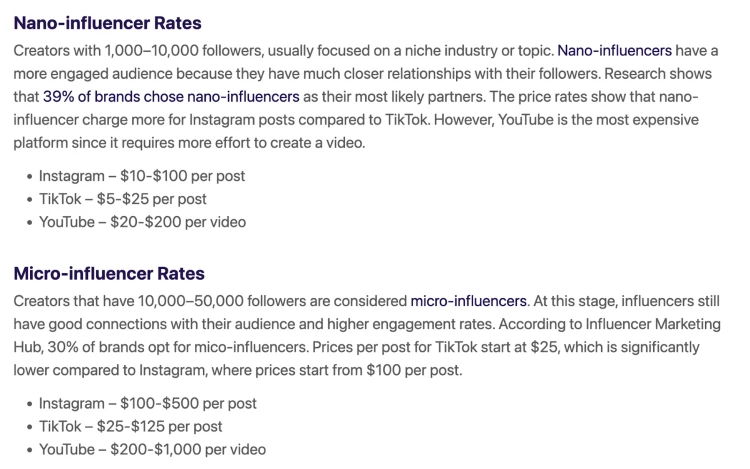
4. Make the process easy and intuitive
Consider ways you can make the influencer’s job easier while subtly ensuring you get the quality of social content you want for your brand.
Share talking points, your brand story, and any relevant studies or reports. Offer high-quality images, videos, or product info that influencers can use in their posts, as well as content creation best practices to inspire their posts.
“Provide affiliates with helpful marketing materials, product samples, newsletters, and consistent communication and support. From there, continuously track performance, recruit new affiliates, and optimize your program based on data insights. Building strong relationships with affiliates across the funnel and fostering one-on-one communication is key to success.” – Lauren Kleinman, Founder and CEO of Dreamday
Want to go a step further? Hold affiliate group webinars or propose a private call to optimize marketing efforts.
Finally, make it easy for affiliates to get in touch with you. Respond to their questions quickly and consider investing in a dedicated team member to reply swiftly to emails and attend to phone calls once your affiliate program expands.
5. Offer attractive incentives
Instead of a one-time sponsorship payment, consider offering a lower upfront payment as well as an enticing amount for every sale they produce. For instance, when you inquire about an influencer’s rate, they may say, “I require a free subscription and $500 upfront.” Here’s how you could reply to that:
“Thanks for your reply. While I couldn’t get $500 approved, I’ve put together something that could work for both of us. I can offer you $200 upfront. Additionally, I can offer you an additional $50 for every sale from your referral. If you produce just seven sales, you’ll make even more money — with no cap on your earning potential. What do you think?”
6. Check in often
Schedule periodic check-ins via email or calls to discuss any questions, feedback, or additional support the influencer may need. Use these check-ins to remind affiliates of upcoming posting deadlines.
Keep notes during or after each check-in. Document any agreements, feedback, or action items for either party. This will help you keep track of progress and ensure accountability.
Finally, remember to encourage influencers to share feedback about the collaboration, including the support they received from you. This can help improve the ongoing campaign and future collaborations.
7. Set the right expectations
Creating content professionally requires time, labor, and skill, so try to compensate partners well and as frequently as possible. Some platforms pay in 30 to 60-day windows, while others require partners to generate a minimum total commission.
Be mindful not to ask for too much from your affiliates. Rather than micromanaging the type of content they put out, give them the freedom to promote as they see fit. Avoid being rigid on matters such as exclusivity and usage rights. Partners may be hesitant to work with brands that have a lot of rules and requirements.
8. Keep an eye on the competition
Study what your competitors are doing and identify gaps that can be filled by your strategy. Analyze their customer feedback and social media reviews to understand pain points that may not be getting addressed. From there, tailor your strategy to fill those gaps and provide superior value.
9. Turn customers into affiliates
Customers who are genuinely satisfied with your products or services can provide more authentic, relatable endorsements than traditional advertising. Besides, happy customers will likely have networks with similar interests or needs. By turning them into affiliates, you tap into their networks, potentially increasing your customer base, sales, and revenue.
Dennis Hegstad, former co-founder of Liverecover offers an actionable tip: “Send emails to customers who left five-star reviews, asking if they’re interested in making money supporting a product/brand they love, then onboard them to your respective affiliate solution of choice.”
Noah Tucker, Founder & CEO of Social Snowball, added: Whenever a new customer places an order on your store, use their data from Shopify checkout to:
1. Automatically create an affiliate account for them.
2. Automatically create a link/code that they can share.
3. Give all of that info to them natively on the thank you page and in post-purchase emails.
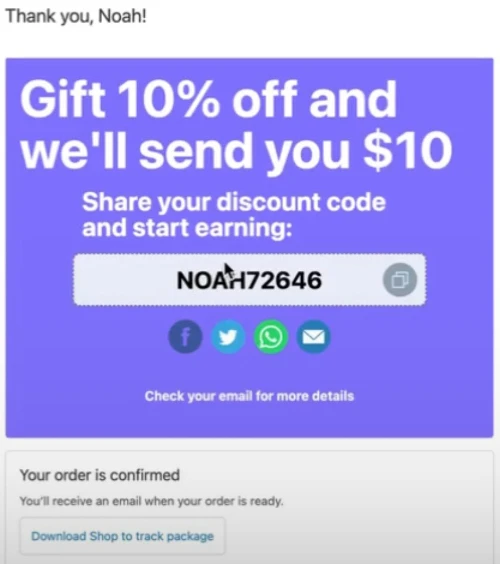
Find Influencers: Start Your Search On Afluencer
As you’ve learned, influencer audience insights are important to ensure you engage with the right influencers for your brand. Audience size is another critical consideration to make in your search. A manual search on social platforms won’t achieve this.
The good news: If you’re a brand looking for influencers, this is all made simple with Afluencer.

With just a few filter selections, you can search through a database of thousands of influencers across many different categories.
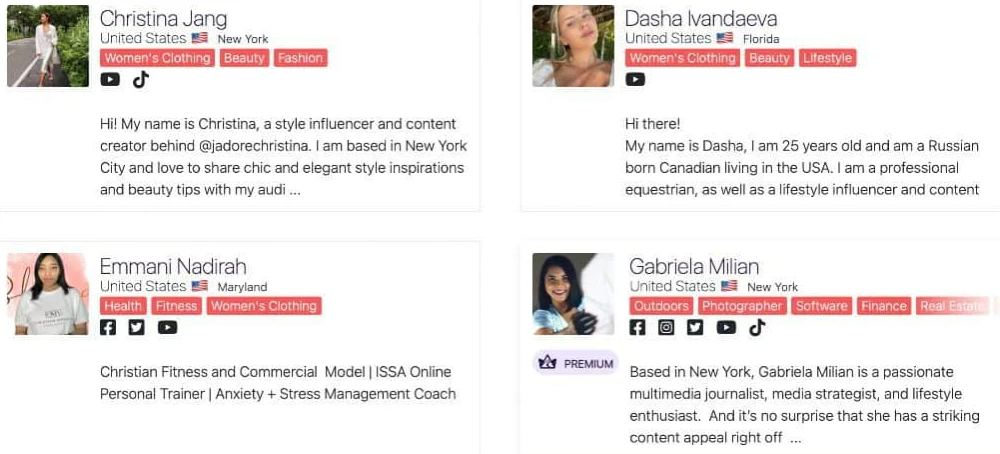
Get Discovered By Influencers: Post A Collab
Creating a collab on Afluencer is the fastest way to get your brand in front of thousands of influencers. Here’s an easy guide:
- Sign up as a brand on Afluencer: If you’re a Shopify merchant, connect your store through the Afluencer Shopify App so prospective influencers can also view your products.
- Create a collab: Name your collab and put in relevant information about your brand and campaign.
- Set influencer criteria: To identify the right influencers, set target demographics like followers, location, interests, social media platform, age group, and gender.

- Highlight your influencer offer: What are you paying for the collab? Set your pay-per-post budget, a commission offer—or both. Don’t know what to pay? $10 per every 1,000 followers is the industry standard, however, you can engage micro-influencers or nano-influencers at much lower rates. With influencers who have a large and engaged following, making an attractive offer becomes more competitive.
Once you’ve posted your collab, the Afluencer algorithm will get your brand in front of thousands of influencers. You can sit back and wait for influencers to apply or quickly search through the database and invite influencers to your collab, directly from the Afluencer platform.
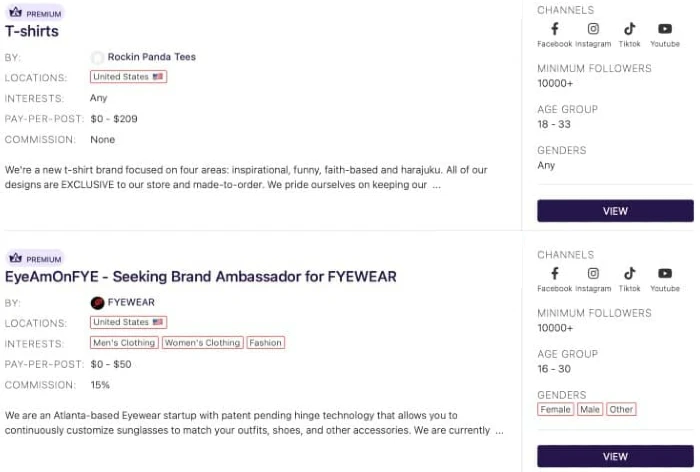
Match, Chat & Book Influencers
Booking influencers to promote your brand is now only a few steps away.

You can now accept or decline applications based on your preference. Once you’ve approved applications, you can chat with influencers to discuss deliverables, payment terms, content rights, and other details.

Collaboration Ideas for Your Affiliate Marketing Partners
Here are several ways retailers can effectively collaborate with content creators to drive revenue with affiliate partners outside of sharing their affiliate links:
Whitelisting
Brands may choose to whitelist creators’ content as paid ads to lead followers into the sales funnel. Coffee brand Beam, for example, leveraged several affiliate partners’ content to run whitelisted story ads on Instagram and Facebook. The brand repurposed the content into story ads with a swipe-up CTA.
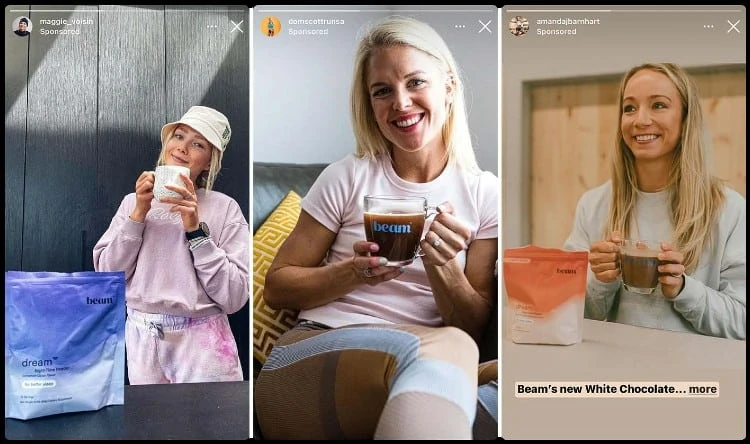
Branded videos
Similar to sponsored posts, branded videos feature a “paid partnership” or “sponsored” tag. They showcase popular creators advertising the brand in a story, reel, or feed post format.
TokyoTreat’s Collab with Japanese gaming Creator Luna is an example of how branded videos work. Luna created an unboxing reel using the brand’s snack box and shared it on Instagram with a “paid partnership” tag. TokyoTreat then also promoted this reel as a sponsored ad to gain more social traction.
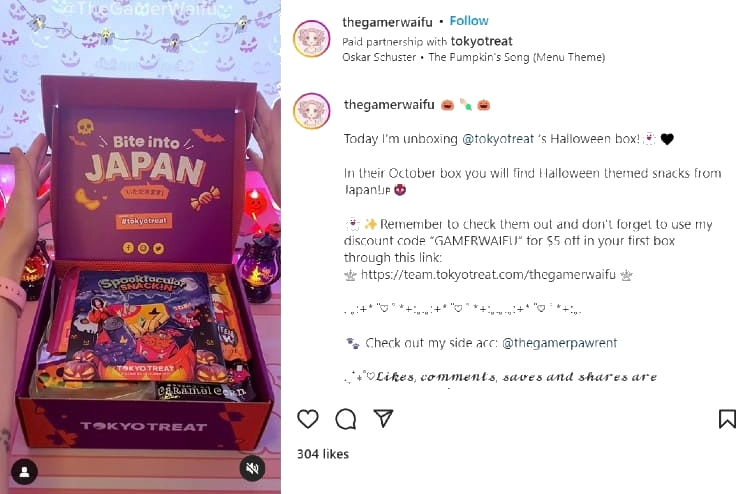
Contests
Leveraging an influencer’s massive following to run a contest or start a challenge is a way to nudge the audience to complete social tasks. This eventually leads to a huge amount of user-generated content and social proof, along with a solid community of hyper-engaged users.
Colgate’s #MakeMomSmile campaign went viral amassing five billion+ TikTok views. Thanks to the brand’s influencer partnerships, what began as a single TikTok video by an influencer (also a Colgate partner) quickly resulted in thousands of videos. It’s a perfect example of how retailers can work with a select few influencers to run a contest and ace UGC marketing.
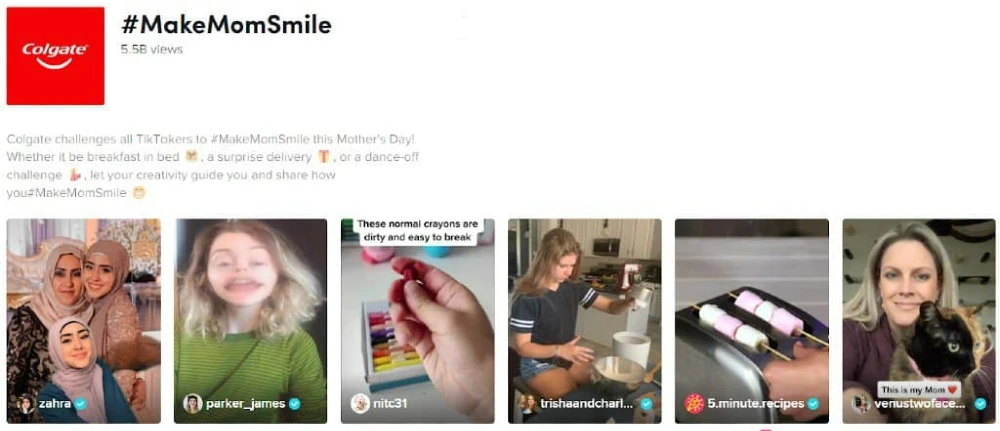
Giveaways
Affiliate codes are great, but partnering with influencers to host giveaways is a fantastic way to create additional buzz around your brand. It also helps your brand win more followers, and engage with a community of interested buyers. Done right, giveaways can boost brand recall and consideration.
Influencers are generally interested in doing giveaways since it’s a quick way to earn followers and improve engagement. Brands can use this tactic in several ways including co-hosting or promoting a giveaway through influencers.
MKBHD (Marques Brownlee) and Dbrand collaborated for a smartphone giveaway. The giveaway included prizes of a new iPhone or Samsung Galaxy Note, with a total of 50 phones up for grabs. Like most giveaways, the rules were simple and easy to perform actions. Participants were required to follow both MKBHD and Dbrand on social media to enter the contest.
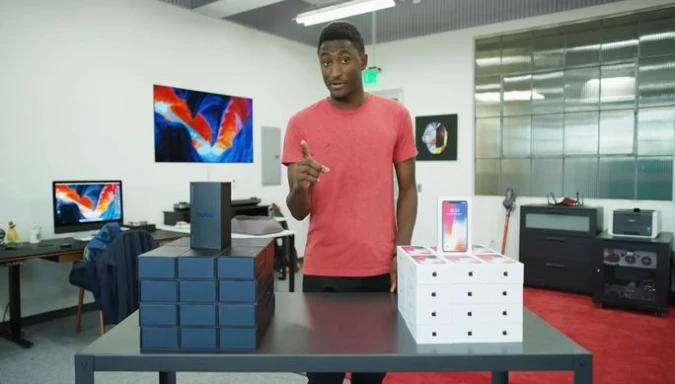
Affiliate Marketing: Making it Work
One of the lesser talked about aspects of affiliate marketing is this: Are you looking at influencers as service providers or partners? When you consider them your brand partners, your perspective (and the influencer’s) shifts.
When it comes to affiliate marketing, the brand-influencer relationship is a long-term investment, where both parties are invested in each other’s growth and success. Creating resources and support for influencers to do their best work is a key part of this puzzle.
Speaker Clay Herbert echoes this sentiment, saying: “Offer a community, have a mix of affiliates (who have both bigger and smaller audiences), give them a place to connect, and share strategies around what’s working and not. That way, they’re not just making money but learning from each other.”
Partnering with the ideal influencers and creators can work extremely favorably for ecommerce brands. Identifying the right people for your brand is now even easier with the Afluencer app for Shopify. It allows you to choose the best fit from an extensive selection of creators from various platforms, niches, and regions.
Ready to get started? Install the Afluencer app for Shopify here.
Ready to Power-Up Your Affiliate Marketing Campaign?
Register with Afluencer for a free trial today and start working with expert influencers who know how to win at the affiliate marketing game.
START FREE TRIAL